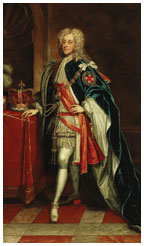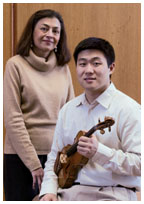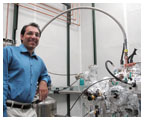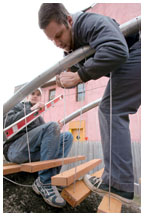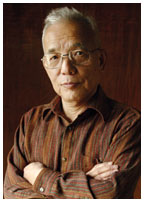
|
March 7, 2007: Notebook
Fields Center plans Prospect Avenue move
Students find finance certificate a ticket for success
BREAKING GROUND—physics
Scanning tools expand superconductor research
From Baghdad to the Wilson
School
Grad students recount their wartime experiences
Global warming pioneer sees early studies confirmed
DISINTEGRATING
DAMAGED
MISSING
IMPALED
|
A
new focus on Princeton’s neglected works of art
With many items lost or damaged, a position is created to oversee
the collection
The portrait of King George II that hangs in the Faculty Room of Nassau Hall had to be sent out for repairs after it was punctured and scraped, probably by the carved eagle atop a falling flagpole. Dozens of paintings, most donated by alumni or their families, have gone missing. The Mather Sundial, one of the most recognizable campus landmarks, is losing its inscriptions to acid rain.
The works are part of the University’s public art collection, which includes portraits, outdoor sculpture, and monuments. Separate from the Art Museum’s collection of more than 68,000 objects, the public art collection consists of more than 600 items that the University acquired either as gifts or — in a few cases — by commissioning them.
For years, items in the collection have suffered from “inadequate oversight and maintenance, vandalism, theft, and accidental, often preventable, damage,” according to a report prepared by the Art Museum for the Priorities Committee, which makes budget recommendations to the University. Adds William Traubel, the University’s maintenance director: “Campus art has a few orphans.”
To address the problem, University trustees in January approved the creation of a new position, manager of campus collections, to oversee the inventory, assessment, and care of Princeton’s public art. That will put a more specific price tag on the cost of repairing and restoring items in the collection, a figure estimated by Art Museum Registrar Maureen McCormick at between $1 million and $2 million.
McCormick praised the timing of the action, noting that as President Tilghman’s arts initiative moves forward, “we have every expectation that more works of art will be commissioned.”
The Princeton Portrait Collection — paintings of notable Princetonians, and works that otherwise relate to the history of the University — makes up the bulk of the public art collection. “It’s the history of the University in people,” McCormick said. Of the 600-plus works in the portrait collection, she said, more than 100 are missing — most from a period in the 1960s and 1970s when works of arts were lent out with little accountability to many locations across campus.
Another 225 to 250 portraits are in storage, and many have been damaged. This can place donor relations “at risk,” the report to the Priorities Committee said, recounting how descendants of benefactors have visited the campus to see portraits of their ancestors. “Too often they have been told the painting or sculpture is in storage having been vandalized or damaged — or worse, that its current whereabouts is simply unknown,” the report said.
Setting criteria for Princeton to acquire or retain public art is an important task that the manager of campus collections will help lead. “Because caring for works requires University resources into perpetuity, they should only be accepted after careful deliberation,” McCormick said. She added that as many as 20 percent of the Princeton portraits could be candidates for “deaccessioning” — disposing of works that are not historically important, or that are damaged beyond repair. Such action would be taken only after scrupulously researching the terms of a work’s acquisition, she said.
The trustees approved spending $75,000 to care for works in the public art collection following a conservation inventory in 1994, but that money has been spent, McCormick said.
She noted that the outdoor sculptures acquired as part of the John B. Putnam Jr. Memorial Collection have been conserved through an endowment from the collection’s anonymous donor, and said she hoped that the same level of care would be provided for the other campus collections.
The most famous work of art in the Princeton Portrait Collection, George
Washington at the Battle of Princeton by Charles Willson Peale, was moved
from the Faculty Room of Nassau Hall to a prominent location in the Art
Museum in early 2006 after the damage to the portrait of King George II
and a similar puncture to a portrait of former Princeton president John
Grier Hibben (both have been repaired). In addition, a number of portraits
in the Faculty Room were covered with protective glass last year. ![]()
By W.R.O.

An architect’s drawing of the new home of the Fields Center, with a planned addition on the right. (Courtesy Ann Beha Architects) |
Fields Center plans Prospect Avenue move
The Carl A. Fields Center is planning to move across Olden Street to the former Elm Club building — a change that the center hopes will mean greater visibility, alumni participation, and programming.
The move will mean that the center will be “seen as, treated as, and visited as another one of the hospitable gathering places on the Street,” said Janet Dickerson, Princeton’s vice president for campus life.
In preparing the former Elm Club at 58 Prospect Ave. for the move, additions that were built on both sides in 1940 will be removed, and a new wing will be built on the north side to house large social events.
Plans were approved by the University trustees in January. Work is scheduled to begin in the spring of 2008, and the move is expected to take place in the fall of 2009.
Center director Makeba Clay said she hoped the Fields Center could tap into enthusiasm demonstrated by minority alumni who attended the Kaleidoscope conference in November on race and community, and a conference of more than 500 black alumni in September.
“The work of the center greatly impacted their Princeton experience, and alumni are looking for more opportunities to get involved with the University and the center,” she said.
The center hopes to strengthen both aspects of its dual mission, Clay said: to encourage discourse and critical thinking by all members of the University community about issues of race, culture, and social justice; and to help members of minority groups “to find a comfortable home away from home.”
The Fields Center began as the Third World Center in the former Osborn Clubhouse in 1971, providing a sense of community for minority students as the University increased its efforts to diversify the student body.
The name was changed to the Carl A. Fields Center for Equality and Cultural Understanding in July 2002 in honor of Fields, who became the first black administrator to hold a significant position at an Ivy school when he became Princeton’s assistant director of student aid in 1964.
The center also is home to Community House, which offers recreational,
cultural, and educational programs for underserved populations of the
Princeton area. ![]()
By W.R.O.

James Park ’07, pursuing a major in music with a certificate in finance, with Swati Bhatt *86, program representative. (Frank Wojciechowski) |
Students find finance certificate a ticket for success
James Park ’07 faced a tough decision as a sophomore: music or money. Though he was fascinated by his economics classes, he felt pulled toward majoring in music.
Ultimately, Park, a violinist in the University orchestra, was able to combine his passions, concentrating in music while pursuing a certificate in finance.
“I viewed the finance certificate as a way for me to continue doing something I wouldn’t have been able to
do otherwise,” Park explained. He connected his two main academic interests in a junior paper: Working under orchestra director Michael Pratt, he used his financial expertise to analyze the orchestra’s marketing, budgeting, and programming decisions.
In his final report, Park recommended ways for Pratt to spend the orchestra’s money more efficiently and to program concerts that would attract large audiences while allowing musicians to play the challenging — and sometimes obscure — repertoire they wanted.
“It’s an ongoing balance between what’s good for the orchestra and what’s good for the audience,” Park said of his recommendations.
Park is one of about 150 seniors pursuing a finance certificate. The certificate, introduced in 1999, quickly has become the University’s most popular: Nearly 15 percent of last year’s graduates earned one. While most finance students major in economics or operations research and financial engineering, about a third combine finance with nonfinancial disciplines such as chemistry, religion, or English.
The program’s rapid growth has led administrators to require applications for admission. Beginning with the Class of 2008, prospective students need a B+ average in the three prerequisite courses (mathematics, statistics, and microeconomics) and a minimum grade of B in each.
“We don’t have an official cap” on the number of students admitted, said Swati Bhatt *86, the program representative and a lecturer in public and international affairs. “What we’ve tried to do by this grade restriction is to keep the quality of the students very select and very top caliber.”
Bhatt described the program — which she said provides a “more rigorous, theoretical approach” than what undergraduate business schools teach — as challenging, and students generally agreed. All need to study financial investments and corporate finance, usually in their junior year; they also must take three elective courses on subjects ranging from the psychology of decision-making and computer networks to corporate restructuring and financial accounting.
Much of the program’s popularity comes from its cachet with potential employers.
“My work in the finance program certainly helped to open doors to me that might have otherwise been closed,” Laura Collins ’06, who majored in English, said in an e-mail. The certificate allowed her to show potential employers not only her quantitative and financial skills but also her interest in the field, added Collins, who works for the economics consulting firm Bates White.
Yet Bhatt and several recent alumni emphasized that the certificate’s appeal isn’t just its power on a résumé.
“Finance is increasingly becoming an advanced academic discipline with a rich body of literature and some very sophisticated math,” said Nitin Walia ’06, a proprietary trader at Lehman Brothers. “I think Princeton has done a good job of focusing on this theory and not making the program ‘pre-professional.’”
Bhatt added that the program’s continued success depends on its ability to interest students in the subject matter for its own sake.
The growth in enrollment has “gone in tandem with ... the fact that we’ve seen such positive trends in financial markets,” she said. When the markets experience a downturn — and finance jobs become less plentiful — students’ interest in the certificate “is going to depend to a large extent on the way our courses are taught.”
Experience suggests that Bhatt may have little to worry about. Between
June 2001 and June 2003, the Dow dropped more than 14 percent —
and the number of finance certificates climbed by more than 45 percent.
![]()
By Christian Burset ’07

Professor Ali Yazdani with one of his lab’s three scanning tunneling microscopes. (Jay Kwak ’09/The Daily Princetonian) |
BREAKING
GROUND—Physics
Scanning
tools expand superconductor research
For drowsy students looking to sneak away for some shut-eye in Jadwin Hall, physics professor Ali Yazdani’s laboratory would seem like an ideal place. The chamber that houses one of the lab’s scanning tunneling microscopes two stories below ground level is “probably the quietest place on campus,” Yazdani says: It has a 40-ton floor that floats on air pistons to negate the effects of seismic activity and vibrations from the traffic on nearby Washington Road, and custom-designed walls that block out sound and radio waves. But nappers would not stay undisturbed for long. The chamber is either sealed for an experiment or being set up for the next one nearly 24 hours a day.
Studying the physics of condensed matter requires time and incredible precision, and the scanning tunneling microscope, or STM, supplies the latter, with an assist from Yazdani’s vibration-proof environment. The device holds a sharp-tipped probe five to six atomic diameters above a sample and scans the surface in neat rows, using a current of tunneling electrons. When the probe is set to adjust its height in order to keep the current constant, the data collected can be used to show the topography of individual atoms.
When the STM was introduced in the early 1980s, it was a breakthrough technology, earning inventors Gerd Binnig and Heinrich Rohr a share of the 1986 Nobel Prize in physics. At first, the STM was used exclusively for imaging, but in the last decade, researchers like Yazdani have learned to use the microscope to manipulate materials, atom by atom. In July 2006, Yazdani’s group was featured on the cover of Nature after it used the STM to add a single atom of manganese to the semiconductor gallium arsenide, creating what Yazdani calls an “ideal laboratory” for studying magnetic properties.
To perform such precise manipulations, Yazdani and his graduate students design and maintain their own STMs. “My students have to be jacks of all trades,” he says. “They’re in the machine shop. ... They’re doing computer programming to get control of the instrument to the level that we need. They analyze data, do image processing, and play architect. ... [But] the science is what drives everything.”
Yazdani says his research is geared toward understanding why things work, but that understanding could also play a role in future applications. His atom-by-atom construction projects, for instance, could help lay the groundwork for tiny electronic devices that use “spin,” a quantum property of electrons, instead of electric charges.
When Yazdani is not building with atoms, he is taking apart another type of extraordinary material: high-temperature superconductors. Superconduc-tors are fascinating, he says, because at extremely low temperatures, their electrons “miraculously pair up,” allowing the materials to carry electricity without resistance. (“High temperature” is relative: Superconductors obtain their remarkable properties only at temperatures well below –300º F.)
Physicists have a precise understanding of low-temperature elemental superconductors, but figuring out how high-temperature superconductors operate has proved more elusive. By scanning high-temperature superconductors with an STM while gradually lowering the surrounding temperature, Yazdani hopes to visualize how superconductivity forms.
Finding a good research topic, Yazdani says, is like pulling on a string
with no end in sight. “If you pull on it and it gets tight very
quickly, you know you haven’t picked a good problem,” he says.
“But if you keep pulling and it keeps coming and keeps being interesting,
then you know you’ve got one.” ![]()
By B.T.

Katherine Marshall *69 (Hyunseok Shim ’08) |
“How the [World] Bank relates to human rights is not something that has been resolved. ... There is a human rights specialist who said there are sins of commission, when you build a dam that takes people from their land, and there are also sins of omission, like when the Bank closes its eyes to the sex trade in Southeast Asia.”
Katherine Marshall *69, senior adviser at the World Bank, speaking Feb.
8 at Robertson Hall on “Ethical Pragmatists: Fighting Poverty from
the Catseat of the World Bank.” ![]()

Beginning this summer, the Princeton Center for Complex Materials (PCCM) will provide research projects for undergraduates from California State University, Northridge, through a National Science Foundation-sponsored partnership aimed at increasing opportunities for scientists from underrepresented minority groups. Faculty and graduate students from Princeton and Cal State Northridge will collaborate on research projects as well.
The partnership, one of 10 nationwide, matches an NSF materials research center with a materials research group at a “minority-serving institution.” More than 30 percent of Cal State Northridge students are Hispanic.
Four or five Cal State Northridge undergraduates are expected to receive nine-week summer research fellowships in Princeton materials labs. Each student will have a graduate student mentor and will interact with at least one professor, according to mechanical and aerospace engineering professor Emily Carter, the University’s point person for the partnership. The lab experience, she said, should give students an understanding of how research groups operate.
The majority of graduate-level researchers in the sciences are white or Asian, but the University is making efforts to reach out to the full demographic spectrum. “There is intellectual capital there that we’re not taking advantage of,” Carter said. “I’m convinced that there are budding scientists out there who haven’t had the opportunity to get excited about research.”
Research in the partnership will focus on computational materials science,
which is central to the work of Carter and her colleague, Professor Nicholas
Kioussis of Cal State Northridge, the NSF grant’s principal investigator.
![]()
By B.T.

Greg Chaney, center, discusses his experience as a Marine civil affairs officer in Iraq as Tobin Bradley, left, and Mark Crow listen during a panel discussion at the Woodrow Wilson School. (Larry Levanti photography) |
From
Baghdad to the Wilson School
Grad students recount their wartime experiences
Seven Woodrow Wilson School graduate students entered the classroom with real-world experience not shared by most of their classmates: military or diplomatic service in Iraq. The group shared perspectives on their wartime experiences Feb. 6 during a panel discussion at Robertson Hall.
Some recounted graphic and painful memories of combat, while others spoke of tactical challenges. Their roles ranged from helping plan the 2003 invasion, to fighting during the initial attacks, to overseeing early elections.
Michael Hunzeker, who served as a Marine armor-platoon commander during the initial invasion, kept the audience rapt as he read excerpts from a journal he had written. “Rule No. 2: Don’t talk about casualties graphically on the radio: It freaks people out,” Hunzeker said. For Matthew Zais, who commanded an infantry platoon, the toughest part of the war was placing in a body bag the first soldier his company had lost.
“At the time that I arrived in 2003 there really wasn’t any set system or plan — we were just putting our fingers in the holes as best we could,” said Tobin Bradley, who served as a political adviser for the Coalition Provisional Authority in 2003 and 2004. Bradley, a Foreign Service officer with the State Department, spent his time in the Green Zone, supervising 19 local elections in an 18-month period.
Communicating with Iraqis was a challenge, Bradley said. He spoke Arabic but said the Iraqis may have been guarded in speaking to him, given his role as an intermediary with U.S. troops. “In any future conflict, we’ve got to find a way to work better,” he said.
Greg Chaney, a civil affairs officer with the Marine Corps, said that cultural differences between American and Iraqi contractors led to delays in reconstruction efforts, noting that Iraqi contractors often did not follow an American workday. He also felt that reconstruction was not a priority for the combat forces.
The students have different plans upon graduation. Some expect to return to careers in the military or Foreign Service; Hunzeker said he has left the Marines and is seeking “a more altruistic career.”
Among the questions from the audience was one about the impact of political
debate about the war on the morale of soldiers in Iraq. Mark Crow, a veteran
of the 101st Airborne Division, said that troop morale generally is not
determined by politics back home. “My experience is that [politics]
doesn’t really impact the way they do the job or how they think
about the job,” Crow said. “It becomes routine, like getting
up and going to class at Princeton.” ![]()
By Jocelyn Hanamirian ’07

(Illustration by Steven Veach) |
CEO pay in the United States grew sixfold from 1980 to 2003, a rate
that has boggled pundits and academics alike. But in a recent paper, eco-nomics
lecturer Xavier Gabaix and colleague Augustin Landier of MIT have explained
the rise in compensation by pointing to a parallel increase: In the same
time period, market capitalization of U.S. firms grew sixfold as well.
Gabaix and Landier have created a model that explains the leap in CEO
pay as an “equilibrium outcome of the substantial growth in firm
size.” Their paper also found that while differences in talent among
chief executives tend to be small, a CEO with a slight edge in ability
can generate big results when working at a large corporation, which in
turn leads to “very large deviations in pay.” ![]()

(Photo by Beverly Schaefer) |
William “Cody” Sonntag ’07, left, and Jonathan Larkin
’08 help assemble a piece of equipment for a playground designed
for a Trenton day care center by about 30 Princeton architecture and engineering
students. The project was the focus of “Building Science and Technology,”
a course offered by the architecture school in the fall semester. Supporting
the installation at Puerto Rican Community Day Care is a $20,000 grant
from the David A. Gardner ’69 Magic Project and work by the Conti
Group of South Plainfield, N.J. The playground was designed “to
maximize the children’s exposure to the magic of imagination while
also educating them,” said Katie Sibert ’07. ![]()

Syukuro Manabe (Frank Wojciechowski) |
Global warming pioneer sees early studies confirmed
Few people noticed 40 years ago when Syukuro Manabe first predicted global warming. Though the so-called greenhouse effect had been identified early in the 20th century by Svante Arrhenius, the Swedish scientist’s models had been flawed. It was Manabe and his colleague, Richard Wetherald, who first estimated the effects correctly.
Manabe, formerly a lecturer with the rank of professor, is now a senior scientist in the Atmospheric and Oceanic Sciences Program. Starting in the mid-1960s, he devised increasingly sophisticated computer programs to calculate what would happen if the amount of carbon dioxide in the Earth’s atmosphere kept increasing. In 1967, he co-authored a study, in the Journal of Atmospheric Sciences, which predicted that rising levels of CO2 due to the burning of fossil fuels could cause surface temperatures to increase, the polar ice caps to melt, and sea levels to rise. Two years later, Manabe co-authored another study that examined the role of oceans in delaying the effects of global warming. Subsequent papers have expanded and deepened his initial conclusions and formed the basis of models now used by the United Nations to assess climate change.
Though Manabe’s findings were relatively ignored at the time, his contributions have become recognized more widely. He was awarded the Roger Revelle Medal from the American Geophysical Union in 1993 and the Volvo Environmental Prize in 1997. He recently discussed his work with PAW’s Mark F. Bernstein ’83.
What was the reaction in the scientific community to your initial findings?
I got pretty good reviews but no big accolades. Longtime modeling of CO2 concentrations was just beginning. People didn’t have a long-enough record to realize how important this kind of thing could be.
Now that the existence of global warming is almost universally accepted, do you feel vindicated?
I’m happy that many of the things I simulated about future trends of the atmospheric state might be confirmed by the following studies — especially as more groups that simulate them seem to agree with my original result.
Has global warming progressed differently than you had predicted?
In the 1967 paper, we predicted that the stratosphere would cool while the troposphere would warm up, and this is exactly what has happened. We published another paper in 1989 that projected that there would be [a large amount of] warming in high northern latitudes but hardly any warming of average sea temperatures in the immediate vicinity of the Antarctic continent. And that, too, seems to be what is happening now.
In your opinion, is there any doubt that global warming is taking place?
I don’t have any doubt because it is consistent with the laws of physics. And if you look at the most recent report of the United Nations Frame-work Convention on Climate Change, this is the first time they have said unequivocally that global warming results from an increase of greenhouse gas — in other words, from man’s activity. Before, it was quite different.
Are recent climate changes reversible?
This is just my personal opinion — that it will be very difficult to stabilize the future growth of CO2. Even if the United States joined the Kyoto protocols, for example, so long as some of the rapidly developing countries such as China, India, and some of the South American countries keep burning fossil fuels at the rate they are doing it, there is a limit to how much can be achieved. But there are side benefits to making the effort to reduce greenhouse emissions. If you use alternative sources of gasoline such as more ethanol, there will be less dependence on foreign oil. If you burn less coal, it will reduce air pollution.
Does the possibility of significant climate change frighten you?
I am not sure. One way to reduce emissions, for example, would be to
rely more on nuclear energy. France is doing that, but nuclear energy
has its own problems, and nuclear fission may be more dangerous than global
warming. If global warming continues, as it is likely to, many parts of
the ecosystem will disappear. If CO2 levels quadruple, the earth’s
climate gets awfully close to what the dinosaurs had 100 million years
ago. The temperatures in the northern parts of Siberia could be 10 degrees
warmer. Is this really dangerous? I’m not sure. If it takes 200
years to reach that point, think how our technology could be able to develop
biotechnologies to adapt. But we have to realize that the climate will
change greatly, and plan ahead. ![]()

RICHARD GOLDEN *54, former associate dean for administration
of the School of Engineering and Applied Science, died Jan. 24 in Princeton.
He was 76. Golden, who joined the engineering school’s administrative
staff in 1990, served as the school’s chief operating officer and
taught a freshman seminar on sustainable development. He oversaw the addition
of the J-Wing and the Friend Center, which opened shortly after he retired
in 2001. From 2001 to 2005 he was a lecturer with the rank of professor
in chemical engineering. ![]()





